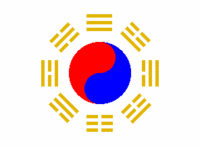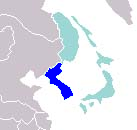Corea

| |

| |
| Official Languages | Corean, Japanese |
| Major Religions | Christianity, Xintò, Buddhism, traditional Corean beliefs |
| Capital | 경성/京城 Kieñseñ |
| Government Type | Constitutional monarchy |
| King | His Majesty the Emperor |
| Regent | Maco, Princess Masaxi |
| Prime Minister | Huañ Kio-An (황교안/黃敎安) |
| Area | 92,142.7 mi2 |
| Population | 85.750.000 (2015) |
| Incorporation into Empire | 1960 |
| Currency | Iañ; 1 iañ = 16 chu = 400 phun |
| Supranational Organizations | Part of Japanese Empire |
| Major Subdivisions | 14 provinces (to) |
Corea is a constituent of the Empire of Japan. Existing in one form or another since the ancient kingdoms of Gogulie (고구려 / 高句麗), Sinra (신라 / 新羅), and Balhai (발해 / 渤海). The descendent kingdom of these, Kolie, gave rise to the international exonym, Corea, handed through China to the trader Marco Polo, of Italy.
Etymology
The name Corea is an exonym derived from Cauli, a transcription of the Chinese 高麗 (simp. 高丽, Kawlej, mod. Gāolì). This was the Hanja for the Corean kingdom of Korie (고려; 918–1392), which ruled most of the peninsula during the time of exploration.
Under Chinese rule, it was referred to as Hanguk 韓國 or land of the Han, something that became oppressive. It was used as a means for the Chinese to assert territorial claim to the peninsula (despite the fact that the "Han" in Hanguk is etymologically unrelated to the ethnonym of the Han Chinese). In an effort to differentiate themselves following their liberation, two names were often used. The first, Mabienguk 마변국/馬弁国, originated from the two southerly, ancient kingdoms of the peninsula, the Mahan Confederation and Bienhan kingdoms. After the first five years and the dissolution of China as an entity, the name became less popular and was replaced with Chosen, 조선/朝鮮, or Kingdom of the Morning Calm. Since the end of the 20th and beginning of the 21st century, a hybrid has arisen, that of Chosen-Uañguk, remembering the Han river flowing through Kieñseñ and the roots of the country.
Note: Corean Romanization is different *there* than *here*.
History
Corea's history, up to the Sino-Japanese War (1894-1895) was essentially the same *there* as *here*.
Historical points of note are:
- Treaty of Ximonosequi: After losing to the Chinese in the Sino-Japanese War, Japan negotiates a leased retention of the Liaodong Peninsula for 25 years. Thus means further Japanese influence in Corea.
- The Corean Client Kingdom: The rules of Kojoñ and his son Sunjoñ are spent meditating the influence of the Chinese and Russians who otherwise tried to subvert their fealty to the Emperor Meidji and Emperor Taixò.
- The Rising Chinese Dragon: China invades Corea, removes Sunjoñ, and places a relative of the Emperor in his stead, who adopts the regnal name of Balhaijoñ. Through the 1920s and 1930s the Chinese forces institute the practice of Comfort Women, with whom a fair number of mixed descent children are born. This practice expands with the subjugation of Japan into a full-fledged effort of Siniticization, to remove all non-Chinese cultural traits from their acquisitions.
- Renewed Freedom, Renewed Unity: Following the Great Oriental War Corea struggled to empanel a functional government, until a compromise was reached in 1960, establishing the Emperor Saisei as hereditary king in a constitutional monarchy in personal union with Japan.
Modern Rulers of Corea
Chosen (Yi) Dynasty (1393-1920)
- 26. 高宗 Kojoñ (Tongzhi 4-Guangxu 22; 1864-1896) - used Chinese eras at the time
- 27. 純宗 Sunjoñ (Meidji 29 - Taixò 15; 1896-1920) - Japanese eras were introduced in his reign
- (28.) 竢祖 Sajo (King-in-exile, Taixò 15 - Xòwa 25; 1920-1949)
Chinese Interregnum (1920-1949)
- . 渤海種 Balhaijoñ (Zaitao, the Chinese Emperor's uncle) (Xuantong 12-Xuantong 41) - used Chinese eras at the time
Republic (1949-1960)
- . 白凡 Kim Ku - 1949-1950 (died in office, probably assassinated)
- . 金日成 Kim Ilsuñ - 1950-1956 (deposed)
- . 李承晩 Li Syñman - 1956-1960 (resigned)
Il Dynasty (1960 - present)
- . 日祖 Iljo (Saisei 9-53; 1960-2004, same person as the Emperor Saisei), founder of Il Dynasty
- . 学宗 Hakchoñ (Gacudai Gannen - Gacudai 3 ; 2004 - 2006), same person as the Empress Gacudai)
- . 東大 Deñdai, Emperor Xigehito (2006 - present)
Provinces of Corea
Corea's current provincial alignments began shortly after King Kojoñ came to power, and have remained in place since that time. They are the division of historic provinces into North and South entities, even though some, like Chhuñchheñ are more an east-west division than north-south.
Due to the spine of mountains along the peninsula most economic development has historically taken place along the western coast, making these provinces more populous. With current efforts, including FastRail-2020, the weight of population is expected to shift from highly populated and congested Kieñgi province to the other provinces.
- North Hamgieñ (Chheñjiñ)
- South Hamgieñ (Hamhyñ)
- North Phieñan (Sinyiji)
- South Phieñan (Phieñseñ)
- Huañhai (Haiju)
- Kañuen (Chhunchhen)
- Kieñgi (Kieñseñ?)
- North Chhuñchheñ (Cheñju)
- South Chhuñchheñ (Taejen)
- North Kieñsañ (Taigu)
- South Kieñsañ (Chhañuen)
- North Chella (Chenju)
- South Chella (Naju)
- Cheiju (Cheiju)
The Autonomous Prefecture of Yanbian has some population that agitates for cession by Beihanguo and Manchuria to Corea. Were this to become reality, it would be admitted as the 15th prefecture, adding a surface area equivalent to both North and South Hamgieñ, and approximately 2,500,000 more Coreans to the country.
This move has been opposed by Russia and Quiòto, as it could heighten tensions in East Primorye. Manchuria has made no comment on the matter.
Geography
Corea is connected to Japan through the Çuxima Xiñcansen tunnel, and is part of the greater Japan Xiñcansen network. The Corean Xiñcansen network is managed by KTX. In the 2014 Parliamentary session, the FastRail-2020 programme was approved, and the nation is now moving forward to connect more of its citizens to high-speed rail connections, allowing 90 minute maximum travel times to Kieñseñ, and three to five hours to Quiòto for most citizens.
Economy
Corea exports gim or nori to Japan and around the world. They have made efforts with technology, as well, licensing designs from Solas Teoranta and finding some success in the Far Eastern markets. It also produces materials from mining and farming, most used domestically, some exported. It is the home of Kïa Motors, a popular car model in the Far East.
Another growing corner of the economy is what's been dubbed the Hanliu Wave (한류 / 韓流). Due to its positioning between Yamato and the Chinas, much of Corea's television and music have been popular and accepted in the wider region, to the point that much of Corea's television programs, movies, and music groups tour and thus export the Corean culture. It is calculated that this amounts to some 両1 billion -- equivalent to £4 billion. This is expected to continue in growth, as the fraternization between Louisianne and Japan has only begun to blossom.
Culture
Religion
For more depth, see also Religions of Corea
Corea is very religiously cosmopolitan, with representatives from nearly every major world religion. The religious capital of Corea must be said to be South Phieñan's Riugioñ, the Jerusalem of the East. The city is home to dioceses of Church of the East, Orthodox, and Latin Rite Catholicism, as well as a burgeoning stake of Mormons (equivalent to diocese), and recent construction on Corea's second LDS temple. There are also pockets of Religion of Light, Armenian Orthodox, Lutheran, Syriac and Coptic Christians, Jews, and even Muslims.
Non-Eastern religions represent about 35-40% of the population of Corea. Xinto represents about 20%, having increased in adherents following China's occupation. Zesucuto has increased over time as the Japanese and Corean Union has persevered. Siñio has persisted, and remain a small but notable minority on the religious stage. It was heavily persecuted under the last kings of Corea and under the Chinese, but saw a rebound in the Revanchism against Chinese Buddhism, Confucianism and Daoism in the years after the Great Oriental War. Nowadays, it is frequent for an observer of Siñio to consider themselves also a Xintoist or a Zesucutoist.
Music
FuziCo is a portemanteau for Corean Fusion music. This encompasses a wide range of music types, including, but not limited to, Jass, Rock, Nu jass, traditional Corean melodies and music types, and other music types within the Japanese Empire.
Jayson Park is the first to become widely known outside of Corea, with his hit, Gañnam Style. Another up-and-coming artist is Jeñ Ioñ Hua, who primarily sings in the Jass, Nu Jass type, but like Mr. Park, will incorporate the rap style of sprechstimme into his pieces. He also participates in the rock band NCBLEU.
With the advent of the space age, music styles have also sought to emulate the new digital future that seems to be burgeoning on the horizon, including Bethinaut (베디넏).
A fusion of the past and present under the sub-genre Electro-Jass, derivative of Nu jass is B3 or Bañthan Big Band.
Cinema and Television
| |||
|---|---|---|---|
| States | |||
| Yamato | Corea | Lùquiù | Ezo | |||
| Protectorate | |||
| Nittatò | |||
| Condominium | |||
| Meidji-dò |
